Article Information
- Wen Zhao Li, Bin He Zhi, Zhi Zhao Wen . 2016.
- Impact of soil conditions on the physiological characteristics of maize plants in an arid region, Northwest China
- Sciences in Cold and Arid Regions, 8(4): 334-342
- http://dx.doi.org/10.3724/SP.J.1226.2016.00334
Article History
- Received: April 10, 2016
- Accepted: June 21, 2016
2. Key Laboratory of Ecohydrology of Inland River Basin, Cold and Arid Regions Environmental and Engineering Re-search Institute, Chinese Academy of Sciences, Lanzhou, Gansu 730000, China
Maize (Zea mays L.) is the main crop in the middle reach of Heihe River, China. According to the local Bureau of Seed Management, Zhangye City supplies maize seeds for more than 40% of maize planting areas of China (Yang and Chen, 2014). Due to limited precipitation, large amounts of groundwater or Heihe river water was required for farmland irrigation over the past few decades, leading to serious water shortage problems (Kang, 2004). In particular, environmental problems such as water and vegetation degradation, soil salinization, and desertification has occurred (Ji et al., 2005; Ren, 2005). Water shortages caused by agricultural development has become a key restriction factor in economic development in this region (Cheng, 2002). Thus, further research on photosynthetic characteristics, leaf transpiration rates, and water use efficiency of maize plants may benefit a reasonable planting scheme for water resources.
Photosynthesis is the most important physical process in plants (Xu et al., 1995), which greatly affects growth and crop yield (Hui et al., 2003). Photosynthetic rate is usually influenced by various environmental factors (Huang et al., 2008). Numerous studies have been conducted on these environmental factors. For instance, Meng et al.(2015)investigated the impact of CO2 concentration and irrigation amount on photosynthetic characteristics. Yu et al.(2015)analyzed photosynthetic characteristics and water use efficiency of maize leaves during different growth stages. Zhang et al.(2015)discussed photosynthetic characteristics under different planting densities of maize plants.
Leaf transpiration is often measured by diffusion porometer (Katerji et al., 2003), steady-state porometer (Horwitz et al., 2008), Li-6400/Li-6400XT portable photosynthesis systems (Wullschleger et al., 2000; Peng et al., 2009) or CIRAS-2 portable photosynthesis (Uehlei et al., 2008). Leaf transpiration rate can be up-scaled to individual plants or canopy, important in providing a reasonable irrigation measure, especially in regions facing water shortages (Zhao L and Zhao W, 2015). In addition, leaf transpiration will not only be influenced by environmental factors but also by plant physiology (Tyree and Sperry, 1988).
Water use efficiency is a comprehensive index indicating the ratio between productivity and water consumed. Water use efficiency can be calculated by three different scales, i.e., leaf, colony and field, and leaf-level water use efficiency is the basis for analyzing the other two (Wang and Liu, 2000). Water use efficiency at the leaf scale refers to the ratio between photosynthetic rate and leaf transpiration rate, which has been widely researched for water-saving agriculture. Zhang et al.(2015)discussed the relationships between water-use efficiency and carbon isotope composition. The constraints on water use efficiency of maize grown in a semi-arid environment were extensively investigated by Tolk et al.(2016). The coupling effects of plastic film mulching and urea types on water use efficiency in the Loess Plateau of China were analyzed by Liu et al.(2016). The impact of saline water irrigation and adapting cultivars on water use efficiency of maize were respectively analyzed by Wang et al.(2016)and Bu et al.(2015). In addition, an optimal method to increase water use efficiency and maize productivity was put forward by adjusting plant density and plastic film mulch (Liu et al., 2014).
From the above analyses, though soil texture and soil water content may highly influence plant physiology (Xie and Su, 2011), little work has been done on the impact of soil conditions on photosynthetic characteristics, leaf transpiration rate, and water use efficiency. It is of great importance for selecting profitable planting area as well as for water resource saving.
In this paper, two common soil textures were selected in the middle stream of Heihe River. Different irrigation volumes were applied, while concrete tanks were built for avoiding lateral and downward water-percolation. The same variety of maize was planted in the concrete tanks. Factors such as plant physiological parameters, meteorological factors, and soil water content were monitored during three days on Jun. 30, Jul. 25 and Aug. 27, 2012. Based on the monitored data, the impact of soil conditions (soil texture and soil water content) on photosynthetic rate, leaf transpiration rate, and water use efficiency were analyzed.
2 Materials and methods 2.1 LocationFigure 1 shows the observation field (Linze Research Station of the Chinese Academy of Science), located in Zhangye City, Gansu Province, China. Maize plant is the main crop in the middle reaches of Heihe River, where the average annual air temperature is about 7.6 ℃; average daily net radiation is less than 200 W/m2; annual precipitation is about 117 mm. Other meteorological information can be referred in Ji et al.(2007)and Liu et al.(2011). Since the annual rainfall is very limited, large amounts of underground water are often consumed by irrigation.
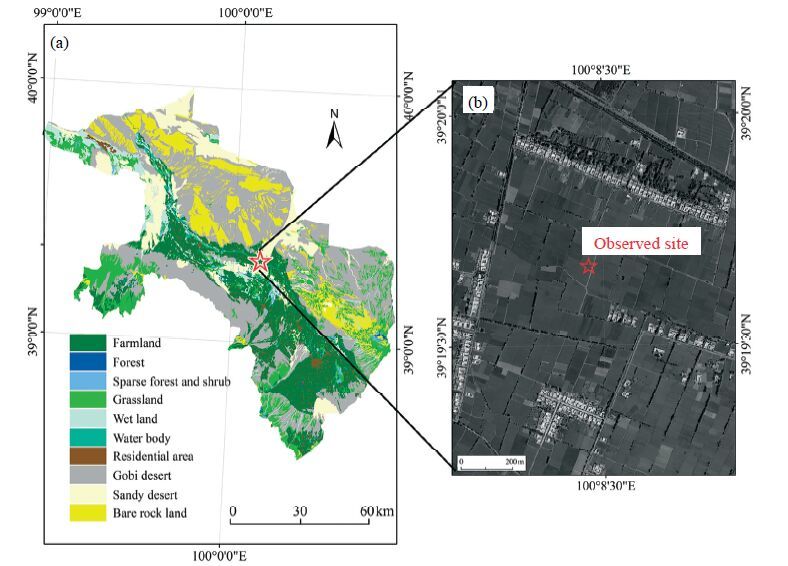
|
| Figure 1 Location of the maize filed studied |
In order to investigate the impact of soil conditions on photosynthetic characteristics and water use efficiencies of maize plants, two common soil textures were selected. The soils were collected around the study area and filled within five concrete tanks, sandy loam within three tanks and sand within two tanks. Concrete walls and bottoms were built to prevent water and nutrition exchanges with the surrounding soils. The schematic diagram is presented in Figure 2. The soil properties, i.e., soil texture, organic content, some key chemical ionic contents, and cation exchange capacity, are summarized in Table 1. The soil textures are defined by the averaged sand/silt/clay contents according to Lal and Shukla (2004). Since more than 80% of the irrigation water are often consumed during the two growing stages, jointing-tasseling and tasseling-filling, three dates, Jun. 30, Jul. 25 and Aug. 27 of 2012, were selected during the two stages. Different irrigation volumes were applied in the five concrete tanks (see Table 1). Due to the relatively higher water retention capability of sandy loam than sand, three different volumes of irrigation were applied for the former soil while two different volumes for the latter one. The watering time was the day before the second monitoring date, i.e., Jul. 25, 2012. Other detailed information is described below.
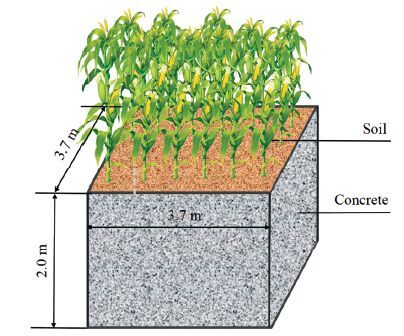
|
| Figure 2 A schematic diagram of concrete tank with maize plants |
| Soil texture | Irrigation (mm) | Depth (cm) | Sand (%) | Silt (%) | Clay (%) | O (g/kg) | N (mg/kg) | P (mg/kg) | K (mg/kg) | CEC (cmol/kg) |
| 0-20 | 54.1 | 27.7 | 18.1 | 11.4 | 67.9 | 33.2 | 160 | 9.1 | ||
| 20-40 | 50.6 | 27.6 | 21.6 | 8.8 | 62.0 | 15.6 | 150 | 7.8 | ||
| 1#: 60 | 40-60 | 45.0 | 33.6 | 21.2 | 7.4 | 50.4 | 7.4 | 140 | 7.7 | |
| 60-80 | 76.4 | 11.5 | 12.0 | - | - | - | - | - | ||
| 80-100 | 90.2 | 3.0 | 6.6 | - | - | - | - | - | ||
| Average | 63.2 | 20.7 | 15.9 | |||||||
| 0-20 | 57.8 | 24.3 | 17.7 | 9.9 | 61.0 | 33.9 | 150 | 9.3 | ||
| 20-40 | 55.4 | 26.2 | 18.3 | 8.1 | 48.7 | 9.5 | 130 | 7.6 | ||
| Sandy loam | 2#: 20 | 40-60 | 71.9 | 14.7 | 13.2 | 7.1 | 34.3 | 32.9 | 90 | 6.6 |
| 60-80 | 85.1 | 5.5 | 9.4 | - | - | - | - | - | ||
| 80-100 | 90.7 | 2.5 | 6.6 | - | - | - | - | - | ||
| Average | 72.2 | 14.7 | 13.0 | |||||||
| 0-20 | 65.5 | 18.2 | 16.2 | 7.6 | 48.7 | 28.2 | 110 | 6.6 | ||
| 20-40 | 76.6 | 11.4 | 11.8 | 5.7 | 36.3 | 30.9 | 100 | 5.2 | ||
| 3#: 0 | 40-60 | 87.5 | 4.9 | 7.5 | 3.3 | 15.8 | 2.2 | 80 | 2.9 | |
| 60-80 | 91.8 | 2.3 | 5.8 | - | - | - | - | - | ||
| 80-100 | 92.3 | 2.0 | 5.5 | - | - | - | - | - | ||
| Average | 82.7 | 7.8 | 9.4 | |||||||
| 0-20 | 83.0 | 7.3 | 9.5 | 5.0 | 29.2 | 33.5 | 100 | 4.8 | ||
| 20-40 | 87.3 | 5.2 | 7.4 | 3.5 | 19.8 | 10.7 | 70 | 4.0 | ||
| 4#: 20 | 40-60 | 89.7 | 3.7 | 6.4 | 2.4 | 17.1 | 3.7 | 60 | 3.4 | |
| 60-80 | 91.3 | 2.8 | 5.8 | - | - | - | - | - | ||
| 80-100 | 91.6 | 2.6 | 5.7 | - | - | - | - | - | ||
| Average | 88.6 | 4.3 | 7.0 | |||||||
| Sand | 0-20 | 80.1 | 8.9 | 10.9 | 5.8 | 31.8 | 39.8 | 90 | 5.3 | |
| 20-40 | 90.6 | 5.1 | 4.2 | 3.8 | 23.0 | 6.8 | 60 | 4.3 | ||
| 5#: 0 | 40-60 | 91.6 | 2.4 | 5.9 | 1.7 | 17.2 | 2.0 | 60 | 3.3 | |
| 60-80 | 92.5 | 1.8 | 5.5 | - | - | - | - | - | ||
| 80-100 | 91.9 | 2.2 | 5.7 | - | - | - | - | - | ||
| Average | 89.3 | 4.1 | 6.4 |
A Li-6400XT portable photosynthesis system (Li-COR, Inc., USA) was adopted to measure plant physiological parameters (photosynthetic rate, and leaf transpiration rate) and meteorological factors (photosyntheticallyactiveradiation, relative air humidity, air temperature and CO2 concentration). The physiological parameters were measured from 8:00 to 18:00 with 2-hour intervals during the three days. Four leaves from three maize plants for each concrete tank were repeatedly monitored.
2.2.3 Soil water contents and plant growing parametersThe soil water content up to 1 m was measured by the evaporation method. Three soil samples were taken by aluminum specimen cans at each depth for repeat measurements. Water was removed by a drying oven at a temperature of 105 ℃. The mass water content was calculated by mass of wet and dry soils. More details about the procedure can be referred to in Lal and Shuka (2004). The measured data in the three days is illustrated in the following section. Some plant growing parameters were also measured on the same days, including plant height, leaf area, fresh weight, dry weight and mass water content of single maize plants. Measurements were in triplicates to reduce measuring errors. The measured data are summarized in Table 2. Deviations resulted from many influencing factors, e.g., seed quality, sunlight and soil fertilizer.
| Date | Soil texture number | Plant height (m) | Leaf area (m2) | Fresh weight (g) | Dry weight (g) | Mass water content (%) |
| Jun. 30 | 1# | 2.03±0.19 | 0.66±0.04 | 836.48±143.32 | 112.30±13.82 | 86.4±0.7 |
| 2# | 2.07±0.14 | 0.62±0.06 | 653.03±31.03 | 79.98±7.21 | 87.7±1.0 | |
| 3# | 1.95±0.13 | 0.55±0.04 | 581.89±82.98 | 77.69±13.34 | 86.6±0.4 | |
| 4# | 1.94±0.08 | 0.63±0.03 | 691.79±119.81 | 95.35±16.44 | 86.2±0.0 | |
| 5# | 2.00±0.16 | 0.57±0.08 | 580.14±124.80 | 81.10±20.82 | 86.0±1.2 | |
| Jul. 25 | 1# | 2.13±0.19 | 0.68±0.08 | 1, 193.20±96.45 | 252.10±45.77 | 78.9±3.8 |
| 2# | 2.23±0.17 | 0.69±0.02 | 1, 134.71±70.21 | 295.08±72.11 | 73.9±6.1 | |
| 3# | 2.21±0.04 | 0.62±0.02 | 969.53±200.61 | 206.45±66.56 | 78.9±2.4 | |
| 4# | 2.22±0.07 | 0.64±0.05 | 1, 118.03±178.85 | 298.64±72.06 | 72.9±6.7 | |
| 5# | 2.24±0.11 | 0.66±0.04 | 1, 059.92±152.64 | 291.20±105.94 | 72.9±5.1 | |
| Aug. 27 | 1# | 2.25±0.04 | 0.62±0.09 | 945.43±96.36 | 318.32±19.24 | 66.1±2.0 |
| 2# | 2.47±0.05 | 0.52±0.06 | 920.95±262.81 | 303.26±101.79 | 67.1±2.9 | |
| 3# | 2.25±0.13 | 0.42±0.04 | 782.80±229.47 | 221.12±64.21 | 71.2±9.1 | |
| 4# | 2.29±0.10 | 0.71±0.20 | 923.18±215.33 | 280.30±70.74 | 69.8±2.7 | |
| 5# | 2.40±0.06 | 0.44±0.15 | 948.90±150.41 | 356.24±62.01 | 62.3±3.8 |
The leaf-level water use efficiency can be calculated by the ratio between photosynthetic rate and transpiration rate. The equation is shown in the following.
where WUE is the leaf-level water use efficiency (‰), P is the photosynthetic rate (μmol CO2/(m2∙s)), T is the leaf transpiration rate (mmol H2O/(m2∙s)) and c is a constant value for unit conversion, where the ratio between the molar masses of CO2 and H2O is 2.44.
3 Results 3.1 Plant physiological parametersThe monitored photosynthetic and leaf transpiration rates as well as calculated water use efficiencies are presented in Figure 3. The photosynthetic rate decreased from Jun. 30 to Aug. 27, which may be caused by the decrease of leaf physiological activity. The same variation trend was observed for the leaf transpiration rate. The lowest values of photosynthetic rate, leaf transpiration rate and water use efficiency occurred in the sand field with 20-mm irrigation (4# on Jun. 30, 2012), which may, to some extent, indicate that the sand field is unsuitable for maize production, compared with sandy loam. On Aug. 27, both photosynthetic rate and leaf transpiration rate were the highest in the sandy loam field. No obvious changes can be found in the water use efficiency.

|
| Figure 3 The average diurnal values of photosynthetic rate, stomatal conductance, and leaf transpiration of the maize plants in the five concrete tanks within the three days |
Since the five concrete tanks were built very close together, the meteorological factors were averaged to show only one series in one day. Figure 4 illustrates the monitored data. It can be seen that small changes were observed for the meteorological factors within the three days. Air temperatures firstly increased to a maximum value of about 40 ℃, and then decreased to a minimum value of about 25 ℃. The same variation trend was observed for active radiation. The value of active radiation on Jun. 30 was obviously larger than that on Jul. 25 or Aug. 25. In contrast, both CO2 concentration and relative humidity reached the minimum value at 14:00. In addition, relatively high values of CO2 concentration were observed on Aug. 27.
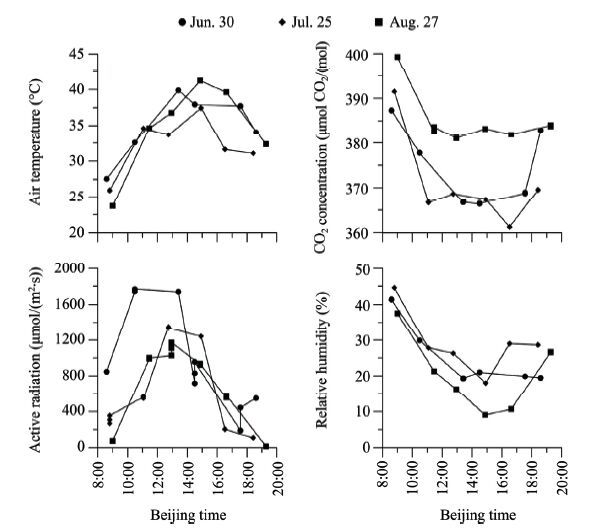
|
| Figure 4 The average diurnal values of air temperature, CO2 concentration, active radiation and relative humidity of the maize plants within the three days |
In order to analyze the influence of soil water content on plant physiological factors, different volumes of irrigation water were applied in the five concrete tanks, three volumes for sandy loam and two values for sand. The monitored soil water contents for the five soil textures are presented in Figure 5. For soils with irrigation water (1#, 2# and 4#), soil contents firstly increased and then decreased during the three days, since the irrigation waters were applied on Jul. 24. For soils without irrigation water (3# and 5#), soil water contents where nearly constant at different depths. The mass soil water contents were approximately 6% without irrigation, which were supposed to be lower than the wilting points (Zhao L and Zhao W, 2014).
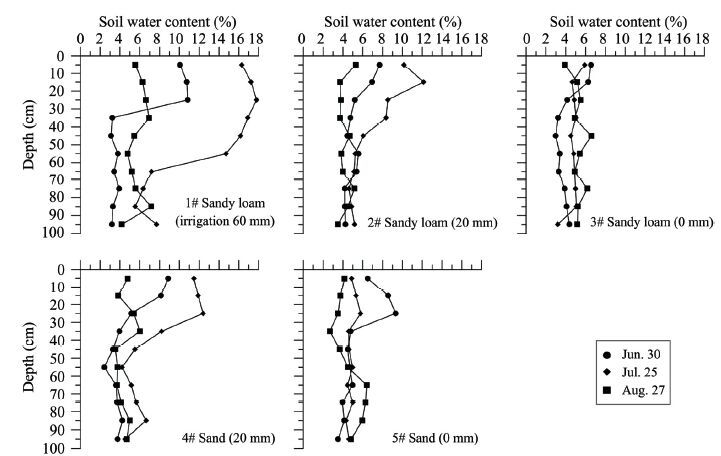
|
| Figure 5 The monitored mass water contents of one-meter-deep top soil layer in the five concrete tanks within the three days |
Figure 6 illustrates the average values of photosynthetic rates, leaf transpiration rates, water use efficiencies and mass soil water contents. It can be seen that soil water content was almost the same for soils on Jun. 30 and Aug. 27, and then the water content differed on Jul. 25 due to different irrigation volumes. Finally, the soil water contents returned to the original levels on Aug. 27. Thus, in the following, the impact of soil texture on photosynthetic rate, leaf transpiration rate and water use efficiency will be discussed based on Jun. 30 and Aug. 27 data, while the impact of soil water content will be discussed based on Jul. 25 data.
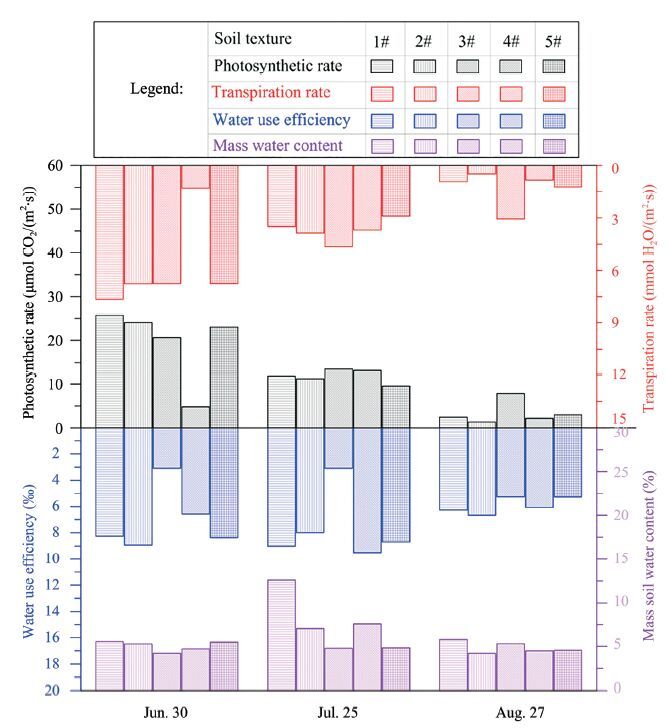
|
| Figure 6 Photosynthetic rates, leaf transpiration rates, water use efficiencies and mass soil water contents for the five soils in the three days |
It can be seen from Figure 6 that both photosynthetic rate and leaf transpiration rate decreased from Jun. 30 to Aug. 27, probably caused by recession of the maize plants. On Jun. 30, the average photosynthetic rate and leaf transpiration rate for sandy loam (1#-3#) were nearly twice of that for sand (4# and 5#). On the other hand, the differences of soil water content and plant parameters were rather small on that day (Table 2 and Figure 5). This may, to some extent, indicate that sandy loam is a better soil than sand for maize production. The possible reason was that the ability in water and nutrition retention of sand texture was relatively weak. As presented in Table 1, available Nitrogen and Phosphorus in sand (4# and 5#) were lower than those in sandy loam (1#-3#). On Aug. 27, both photosynthetic rate and leaf transpiration rate of maize plants in concrete tank 3# were larger than those in the others. This may be caused by the delay of recession of the maize plants in concrete tank 3#, since the average water content of the maize plants was the highest (Table 2). As for water use efficiency, the lowest value in concrete tank 3# on Jun. 30 may be associated with the smallest leaf area (Table 2).
4.2 The impact of water contentAs presented in Figure 6, soil water content in concrete tanks 1#, 2# and 4# on Jul. 25 increased by different irrigation volumes (Table 1). The average soil water content in the concrete tanks was 12.5% in 1#, 7.0% in 2#, 7.5% in 4#, 4.8% in 3#, and 4.9% in 5#. Although the soil water contents were different, the monitored photosynthetic rate and leaf transpiration rate were almost the same. It seems that photosynthetic rate and leaf transpiration rate does not increase in the short term after irrigation. In other words, single irrigation may be insufficient, and thus a frequent irrigation measure with relatively low one-time volume may be required to increase the photosynthetic and leaf transpiration rate, and consequently the crop yield. In addition, the smallest leaf area (Table 2) may be the reason of the lowest water use efficiency in concrete tank 3# on Jul. 25, showing similar characteristics on Jun. 30. This may indicate that single irrigation would not increase water use efficiency.
5 SummaryIn order to analyze the impact of soil conditions on the physiological characteristics of maize plants, a comprehensive monitoring program was initiated in the middle reach of Heihe River, China in 2012. The observations included photosynthetic rate, leaf transpiration rate, soil water content, plant growing parameters, and meteorological factors. Based on monitored data, leaf-level water use efficiency was calculated. Two common soils and three different irrigation volumes were designed.
The soil water content before irrigation and plant growing parameters were very similar for maize plants growing in the two soils, however both the photosynthetic and leaf transpiration rates in concrete tanks 4# and 5# were much lower than the other three. This indicates that sand is worse than sandy loam for maize production, since sand texture provided relatively weak ability in water and nutrition retention. After single irrigation, soil water content increased to about three times the soils without irrigation, however both photosynthetic rate and leaf transpiration rate did not increase in the short term after irrigation. This indicates a frequent irrigation measure with relatively low one-time volume is required. As for the water use efficiency, the leaf area may be the priority to be considered.
These results may be considered preliminary, since we monitored only three days. Physiological characteristics of maize plants can be influenced by various factors, not just soil conditions. Thus, long-term monitoring programs, taking more influencing factors into consideration, should be initiated to further reveal the physiological characteristics of maize plants. This would provide a good reference for the development of an efficient irrigation management plan.
Acknowledgments:This work was supported by the China Postdoctoral Science Foundation (Grant No. 2015M572622) and the National Natural Science Foundation of China (Grant No. 41501044). The authors greatly appreciate the help from Prof. YongZhong Su, Dr. XiBin Ji and Dr. BoWen Jin in carrying out the experiments.
| Bu LD, Chen XP, Li SQ, et al, 2015. The effect of adapting cultivars on the water use efficiency of dryland maize (Zea mays L. ) in northwestern China. Agricultural Water Management, 148: 1–9. doi: 10.1016/j.agwat.2014.09.010 |
| Cheng GD, 2002. Study on the sustainable development in Heihe River watershed from the view of ecological economics. Journal of Glaciology Geocryology, 24: 335–343. doi: 10.3969/j.issn.1000-0240.2002.04.001.(inChinese) |
| Horwitz DA, Zheng SG, Gray JD, 2008. Natural and TGF-β-induced Foxp3+ CD4+ CD25+ regulatory T cells are not mirror images of each other. Trends in Immunology, 29(9): 429–435. doi: 10.1016/j.it.2008.06.005 |
| Huang G, Zhao XY, Cui JY, 2008. Photosynthetic and water use efficiency characteristics of two annuals under drought stress in Korqin Sandy Land. Acta Botanica Boreali-Occidentalia Sinica, 28(11): 2306–2313. doi: 10.3321/j.issn:1000-4025.2008.11.026.(inChinese) |
| Hui HX, Xu X, Li QR, 2003. Exogenous betaine improves photosynthesis of Lycium barbarum under salt stress. Acta Botanica Boreali-Occidentalia Sinica, 23(12): 2137–2142. doi: 10.3321/j.issn:1000-4025.2003.12.015.(inChinese) |
| Ji XB, Kang ES, Chen RS, et al, 2005. Estimation of ground water budget at the representative irrigated area in the middle stream of Heihe River. Hydrogeology & Engineering Geology, 32(6): 25–29. doi: 10.3969/j.issn.1000-3665.2005.06.007.(inChinese) |
| Ji XB, Kang ES, Chen RS, et al, 2007. A mathematical model for simulating water balances in cropped sandy soil with conventional flood irrigation applied. Agricultural Water Management, 87: 337–346. doi: 10.1016/j.agwat.2006.08.011 |
| Kang ES, 2004. Water resources relating to desertification in the Hexi area of Gansu Province, China. Journal of Glaciology Geocryology, 26: 657–667. doi: 10.3969/j.issn.1000-0240.2004.06.001.(inChinese) |
| Katerji N, Van Hoorn JW, Hamdy A, et al, 2003. Salinity effect on crop development and yield, analysis of salt tolerance according to several classification methods. Agricultural Water Management, 62(1): 37–66. doi: 10.1016/S0378-3774(03)00005-2 |
| Lal R, Shukla MK, 2004. Principles of Soil Physics. USA: CRC Press. |
| Liu B, Zhao WZ, Jin BW, 2011. The response of sap flow in desert shrubs to environmental variables in an arid region of China. Ecohydrology, 4: 448–457. doi: 10.1002/eco.151 |
| Liu JL, Bu LD, Zhu L, et al, 2014. Optimizing plant density and plastic film mulch to increase maize productivity and water-use efficiency in semiarid areas. Agronomy Journal, 106(4): 1138–1146. doi: 10.2134/agronj13.0582 |
| Liu QF, Chen Y, Liu Y, et al, 2016. Coupling effects of plastic film mulching and urea types on water use efficiency and grain yield of maize in the Loess Plateau, China. Soil and Tillage Research, 157: 1–10. doi: 10.1016/j.still.2015.11.003 |
| Meng FC, Zhang JH, Hao C, et al, 2015. Effects of elevated CO2 and different irrigation on photosynthetic parameters and yield of maize in Northeast China. Acta Ecologica Sinica, 35(7): 2126–2135. doi: 10.5846/stxb201306041336.(inChinese) |
| Peng ZY, Wang MC, Li F, et al, 2009. A proteomic study of the response to salinity and drought stress in an introgression strain of bread wheat. Molecular & Cellular Proteomics, 8(12): 2676–2686. doi: 10.1074/mcp.M900052-MCP200 |
| Ren JH, 2005. Effects of water resources exploitation on ecoenvironment of Heihe River Basin. Bulletin of Soil and Water Conservation, 25: 94–96. doi: 10.3969/j.issn.1000-288X.2005.04.025.(inChinese) |
| Tolk JA, Evett SR, Xu WW, et al, 2016. Constraints on water use efficiency of drought tolerant maize grown in a semi-arid environment. Field Crops Research, 186: 66–77. doi: 10.1016/j.fcr.2015.11.012 |
| Tyree MT, Sperry JS, 1988. Do woody plants operate near the point of catastrophic xylem dysfunction caused by dynamic water stress? Answers from a model. Plant Physiology, 88(3): 574–580. doi: 10.1104/pp.88.3.574 |
| Uehlein N, Otto B, Hanson DT, et al, 2008. Function of Nicotiana tabacum aquaporins as chloroplast gas pores challenges the concept of membrane CO2 permeability. The Plant Cell Online, 20(3): 648–657. doi: 10.1105/tpc.107.054023 |
| Wang HX, Liu CM, 2000. Advances in crop water use efficiency research. Advances in Water Science, 11(1): 99–104. doi: 10.3321/j.issn:1001-6791.2000.01.018.(inChinese) |
| Wang QM, Huo ZL, Zhang LD, et al, 2016. Impact of saline water irrigation on water use efficiency and soil salt accumulation for spring maize in arid regions of China. Agricultural Water Management, 163: 125–138. doi: 10.1016/j.agwat.2015.09.012 |
| Wullschleger SD, Wilson KB, Hanson PJ, 2000. Environmental control of whole-plant transpiration, canopy conductance and estimates of the decoupling coefficient for large red maple trees. Agricultural and Forest Meteorology, 104(2): 157–168. doi: 10.1016/S0168-1923(00)00152-0 |
| Xie TT, Su PX, 2011. Research on leaf photosynthetic characteristics and water use efficiency of sweet sorghum under different land types in arid region. Scientia Agriculatura Sincia, 44(2): 271–279. doi: 10.3864/j.issn.0578-1752.2011.02.006.(inChinese) |
| Xu SM, Dai JX, Shen XY, et al, 1995. The effect of water stress on maize photosynthetic characters and yield. Acta Agronomica Sinica, 21(3): 356–363. doi: 10.3321/j.issn:0496-3490.1995.03.017.(inChinese) |
| Yang Y, Chen JX, 2014. Reasons and countermeasures for frequently maize seed planting without certificate. Seed World, 7: 1–2. doi: 10.3969/j.issn.1000-8071.2014.07.008.(inChinese) |
| Yu WY, Ji RP, Feng R, et al, 2015. Response of water stress on photosynthetic characteristics and water use efficiency of maize leaves indifferent growth stage. Acta Ecologica Sinica, 35(9): 2902–2909. doi: 10.5846/stxb201306101632.(inChinese) |
| Zhang CZ, Zhang JB, Zhang H, et al, 2015. Mechanisms for the relationships between water-use efficiency and carbon isotope composition and specific leaf area of maize (Zea mays L. ) under water stress. Plant Growth Regulation, 77(2): 233–243. doi: 10.1007/s10725-015-0056-8 |
| Zhang Q, Zhang HS, Song XY, et al, 2015. The effects of planting patterns and densities on photosynthetic characteristics and yield in summer maize. Acta Ecologica Sinica, 35(4): 1235–1241. doi: 10.5846/stxb201305020885.(inChinese) |
| Zhao LW, Zhao WZ, 2014. Water balance and migration for maize in an oasis farmland of northwest China. Chinese Science Bulletin, 59(34): 4829–4837. doi: 10.1007/s11434-014-0482-4 |
| Zhao LW, Zhao WZ, 2015. Canopy transpiration obtained from leaf transpiration, sap flow and FAO-56 dual crop coefficient method. Hydrological Processes, 29(13): 2983–2993. doi: 10.1002/hyp.10417 |
 2016, 8
2016, 8


